In 1994, soon after completing his architectural studies at Trinity College Dublin, Kieran Stanley landed in Hanover in Germany. He started work there with an architectural practice that had just been commissioned to develop and plan the city's zoo, a new type in Europe. He was principal designer there until 1999, when he established the Dan Pearlman Group in Berlin with his wife, Nicole Srock. It's a Berlin-based group of owner-managed creative agencies that has grown over the past two decades to have 120 interdisciplinary employees worldwide.
As chief executive and creative director of Dan Pearlman Experience Architecture, Stanley quickly realised that the projects they were working on were not just about architecture: they were about developing a comprehensive understanding of the zoo, its cultural and historical background and its zoological, educational and operational objectives. Story building is now a distinguishing feature of his architecture office.
We have come a long way from the beginnings of European zoo buildings, in the 13th century, to today's behavioural-enrichment concepts
Stanley has become one of the world's leading zoo designers, with successful projects in the UK, Denmark, South Korea, Uzbekistan, Russia and China, as well as several benchmark projects in Germany and around Europe. Stanley hopes to shape the role zoos play today and in the future. He believes that, while zoos will continue to evolve, they will always serve a critical role as places where people meet animals face to face and "fall in love with wildlife".
Today a zoo is a complex leisure destination, and not every zoo is the same, he says. “We have come a long way from the beginnings of European zoo buildings, in the 13th century, to today’s behavioural-enrichment concepts. Heini Hediger, who is still regarded as the founder of modern zoological thinking, set out the four main tasks of a modern zoo: education, research, leisure and conservation.
“The ex-situ and in-situ conservation work being done, more or less exclusively by zoos, is one of the strongest arguments we have to emphasise for the importance of any zoo’s existence.” (Ex-situ conservation is the relocation of endangered or rare species from their natural habitats to protected areas equipped for their protection and preservation. In-situ conservation is the conservation of genetic resources in natural populations of plant or animal species .)

“Despite these important tasks, there are still negative associations of zoos,” Stanley says. “There are people who perceive zoos to be institutions whose only target is to incarcerate animals and put them on exhibit for fun and profit. This view has quite a strong lobby as well as a loud voice. Therefore a modern zoo has always to answer the questions: are we communicating the central role of conservation enough? Is conservation built into our zoo DNA? Into our strategic development plan? Into our design and communication, so that our guests can understand what we are doing?”
Stanley says that zoos may answer those questions, “but probably not always enough. As a zoo designer, it is my task to help make conservation experienceable.”
He says that by creating authentic, detailed settings, zoos enable visitors to understand and take in the feel of the animal’s habitat, learn some stories intuitively and even have direct encounters with the animal. “If we change what a visitor may be used to, we can awaken fascination,” he says.
Zoos need to be 'authentic, do good work and effectively communicate this to the public. This means being transparent about the work you are doing and demonstrating to people that animal welfare is your highest concern'
He says social media allows zoo visitors to participate in or actually act for a conservation project. “We should not forget that if we deliver positive messages we can empower our visitors, and they will ultimately become ambassadors, not visitors.”
The key to any zoo’s success lies in coming up with a tailor-made approach that embraces “co-operation, diversification, reinterpretation, reinvention and repositioning – or being virtual.” He says that the future success of zoos is “contingent upon adopting and living by strong values”.
Zoos need to be “authentic, to live according to values, to do good work and to effectively communicate this to the public”, Stanley says. “This means being transparent about the work you are doing and demonstrating to people that animal welfare is your highest concern.”
Above all, zoos should inspire visitors by “shifting their points of view and bringing them into the centre of the action. As I like to say, if knowledge is a bank and imagination the currency, the ultimate future investment is experience.”
Dublin Zoo reopens to the public on Monday, April 26th













